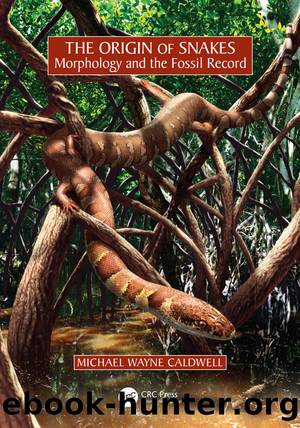The Origin of Snakes by Michael Wayne Caldwell

Author:Michael Wayne Caldwell
Language: eng
Format: epub
Publisher: CRC Press
Published: 2019-06-10T00:00:00+00:00
The Postcranial Skeleton
Basics of the Postcranium and “Short Tails”
While it is a commonly recognized fact that modern snake lizards are legless, having lost the fore- and rear limbs, what is less widely known is that limblessness, and in particular limb reduction to complete limbloss, is quite common in modern and ancient lizards of all kinds, in fact, in all tetrapods (Caldwell, 2003), not just snake lizards. According to Greer (1991), limb reduction and limb loss have occurred in modern lizards (snake lizards included) at least sixty-two times in fifty-three different lizard lineages, with the exceptions of the non-snake lizards Varanidae, Lacertidae, Gerrhonotidae, and Iguanidae. The number of clades presenting completely limbless forms includes the dibamids, amphisbaenians, pygopodid geckos, annielline anguids, ophisaurine anguids, gerrhosaurids, cordylids, acontine scincines, feylinid scincines, numerous genera of scincids (twenty-five different scincid lineages [Greer, 1987, 1990, 1991]), gymnophthalmids, and of course nearly 4000 species of modern snake lizards (see also Caldwell, 2003).
Interestingly though, while there is absolutely no vestige of the pectoral girdle and thus no forelimb, there are a rather large number of modern species that have retained recognizable vestiges of the pelvic girdle, and a few even possess a femoral spur proximate to the cloaca inside of which is a tiny “femur” articulating with a highly modified and reduced pelvic girdle. However, the balance of modern snake lizards, that is, the several thousand species of modern caeonophidians, possess no remnants of the pelvic girdle elements as evidenced in more basal modern snakes (i.e., booids, anilioids, etc.). Of particular interest, though, is the presence of pelvic girdle remnants in scolecophidians, especially considering the arguments rendered above concerning scolecophidians as derived caenophidian snake lizards.
An associated, and likely evolutionarily and developmentally linked result of this process of limbloss to limb reduction is that modern snake lizard bodies are also extremely elongate. In the absence of girdle anatomies to assist in demarcating body regions, generations of scholars (e.g., Bellairs and Underwood [1951]; Hoffstetter and Gasc [1969]) considered the neck lost in snake lizards and homogenized the axial skeletal regions of snake lizards from the usual cervical, thoracic, lumbar, sacral, and caudal to only three barely distinguishable regions, that is, precloacal, cloacal, and postcloacal/caudal. Not too surprisingly, elongation has not occurred uniformly throughout the postcranial skeleton of snake lizards (Rochebrunne, 1881: Table 1), and as with most axially elongate vertebrates is accomplished developmentally by increasing the number of somites (i.e., length increases by increased segmentation [e.g., Gómez et al., 2008]) and not by increasing the size of any one somite (though there are a couple of vertebrate exceptions, for example, the necks of giraffes or tanystropheids [Carroll, 1988], where the neck vertebrae are grossly elongated by 3–4 times, the length of a typical thoracic or dorsal vertebra).
As was reviewed first by Rochebrune (1881) (note: this nineteenth-century French zoologist is also the namesake of the first-ever described fossil snake, Simoliophis rochebrunei [Sauvage, 1880]—see Chapter 2), followed by Sood (1946) and of course, the twentieth-century classic by Hoffstetter and Gasc (1969), the
Download
This site does not store any files on its server. We only index and link to content provided by other sites. Please contact the content providers to delete copyright contents if any and email us, we'll remove relevant links or contents immediately.
Sapiens: A Brief History of Humankind by Yuval Noah Harari(14322)
Sapiens by Yuval Noah Harari(5325)
Pale Blue Dot by Carl Sagan(4960)
Homo Deus: A Brief History of Tomorrow by Yuval Noah Harari(4874)
Livewired by David Eagleman(3730)
Origin Story: A Big History of Everything by David Christian(3666)
Brief Answers to the Big Questions by Stephen Hawking(3394)
Inferior by Angela Saini(3295)
Origin Story by David Christian(3170)
Signature in the Cell: DNA and the Evidence for Intelligent Design by Stephen C. Meyer(3103)
The Gene: An Intimate History by Siddhartha Mukherjee(3076)
The Evolution of Beauty by Richard O. Prum(2966)
Aliens by Jim Al-Khalili(2804)
How The Mind Works by Steven Pinker(2782)
A Short History of Nearly Everything by Bryson Bill(2666)
Sex at Dawn: The Prehistoric Origins of Modern Sexuality by Ryan Christopher(2500)
From Bacteria to Bach and Back by Daniel C. Dennett(2463)
Endless Forms Most Beautiful by Sean B. Carroll(2447)
Who We Are and How We Got Here by David Reich(2418)
